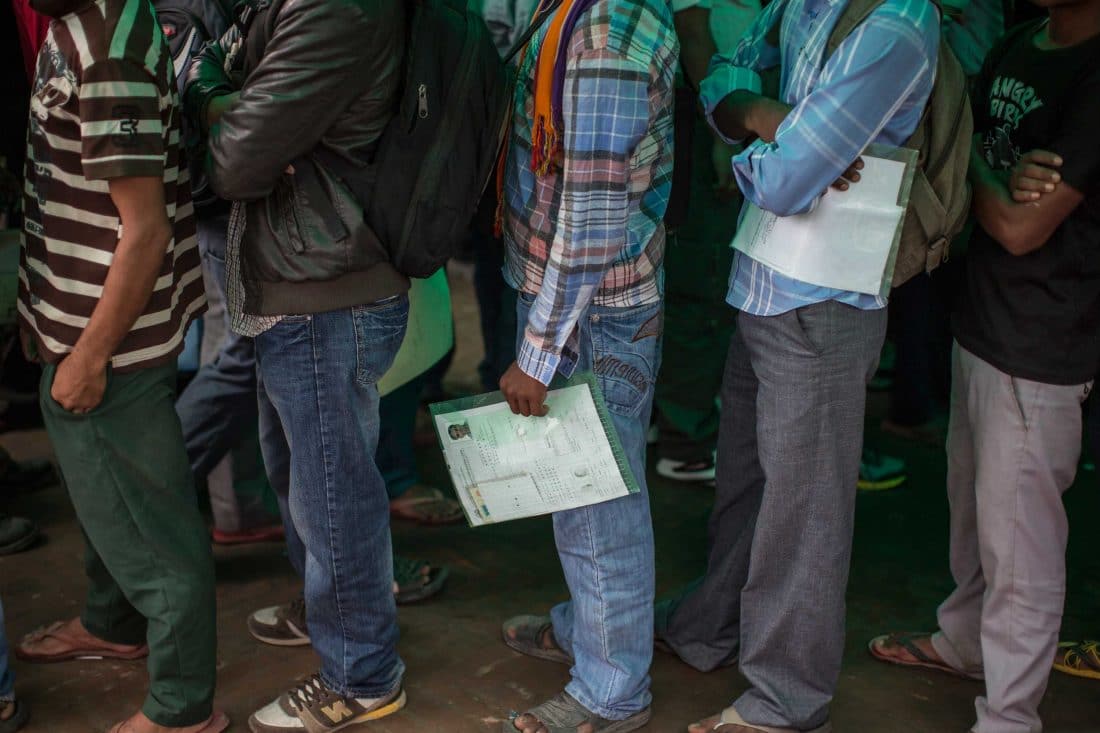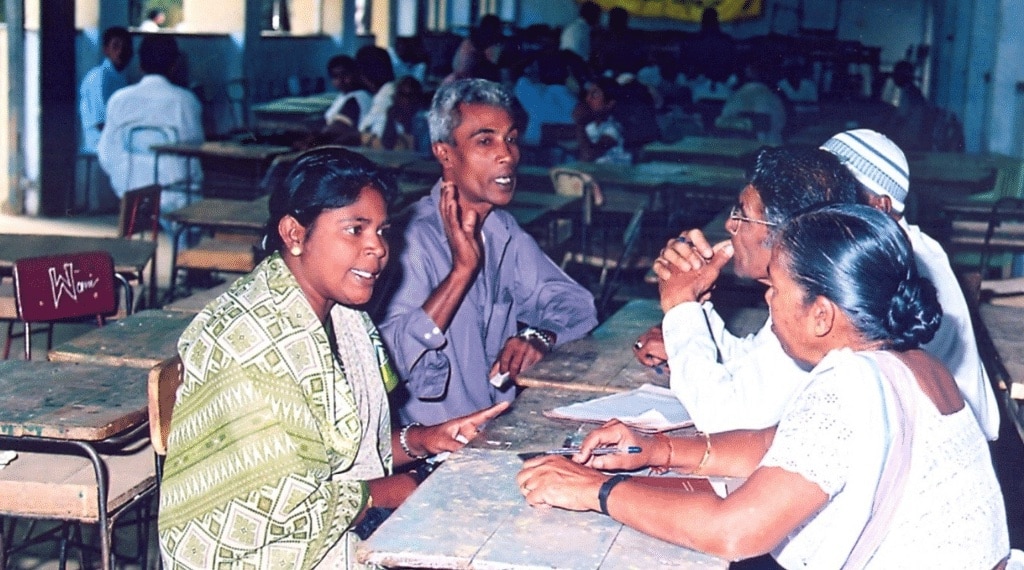InAsia
Insights and Analysis
Pandemic Dramatically Alters Path of Migrant Workers
May 12, 2021
Labor migration often reflects such basic human motivations as the desire for a decent life and physical and financial security. Throughout Asia, however, Covid-19 has put labor migration into reverse. As economies went into crisis in 2020 amid pandemic containment measures and mobility restrictions, Asia’s overseas migrant workers were among the first to lose their jobs. Millions returned home, while thousands more found themselves unemployed and stranded abroad. These migrant workers have been dramatically affected by the pandemic in ways that are often underestimated.

Migrant workers applying for Nepali passports before the pandemic. Hundreds of thousands are now coming home. (Photo: Conor Ashleigh / The Asia Foundation)
Nepali migrant workers have been no exception. We spoke to Chantin (not her real name), from Nepal’s Kavre District, in December 2020. After working for two years as a hospital cleaner in Dubai, she told us, she was laid off due to the pandemic in March 2020 and faced a very difficult return. There were no flights to Nepal, so the company provided her and other former employees with shelter. After five months, with help from the Nepalese Embassy, she was able to fly to Kathmandu, where she received support from a local civil society organization during her quarantine period. Chantin says she doesn’t intend to work overseas again after the pandemic; instead, she hopes to find start-up capital for a business of her own.
Over the course of 2020 and into 2021, employment in jobs typically held by Nepali migrants declined by 30 percent in the United Arab Emirates and Malaysia and 20 percent in Qatar and Saudi Arabia. Due to their overrepresentation in the domestic and hospitality sectors, female migrant workers have been especially vulnerable to unemployment during the pandemic.
Over the course of 2020 and into 2021, employment in jobs typically held by Nepali migrants declined by 30 percent in the United Arab Emirates and Malaysia and 20 percent in Qatar and Saudi Arabia.
Migrant workers who managed to keep their jobs often faced reduced work hours, deferred wages, unpaid leave, and insufficient access to basic services. Documented migrants sometimes benefit from host or home country protections, but undocumented and domestic workers usually do not, and therefore face a greater risk of discrimination, workplace abuse, and forced labor.
These factors have contributed to the decision of many Nepali migrant workers to return home. Recruitment agencies in Nepal estimate that as many as 500,000 Nepali workers will do so as a result of the pandemic.
The return of migrant workers worldwide requires not just the safe evacuation of millions of people, but also the reintegration of returnees into national labor markets and the provision of support services to combat pandemic-related financial and social adversity. Measures to do this rely heavily on the support of both home and host countries. Unfortunately, Nepal’s current support services for migrant workers returning during the pandemic have been largely insufficient.
Unfortunately, Nepal’s current support services for migrant workers returning during the pandemic have been largely insufficient.
Fearing that they would add to the spread of Covid-19, the government initially barred migrant workers from returning to Nepal altogether, ignoring the grave human security implications of their plight, despite the fact that, by law, the government must protect the human and labor rights of migrant workers and provide for the smooth socioeconomic reintegration of returnees, especially during emergencies. In early June, however, under an order from the Supreme Court, Nepal helped some stranded workers by bearing the cost of air tickets, health checkups, and other expenses. This repatriation scheme eventually brought home 103,807 Nepalis, including some migrant workers.
As a signatory to the Global Compact on Migration, Nepal is also obligated to reintegrate returnees into community life by providing them with equal access to social protection, employment opportunities, and “skills recognition”—identifying new skills acquired overseas and matching them with the domestic labor market. The government has taken steps in this direction with nationwide entrepreneurship development programs, and it has launched a comprehensive reintegration plan that includes financial literacy and vocational training, psychosocial support, shelter, and direct grants to individuals.
As a signatory to the Global Compact on Migration, Nepal is also obligated to reintegrate returnees into community life by providing them with equal access to social protection, employment opportunities, and skills recognition.
Yet these services are only available to migrants with labor permits, excluding thousands of undocumented workers, who are also ineligible for other facilities such as Nepal’s Foreign Employment Welfare Fund, which provides compensation in case of death, injury, or serious illness. Even when they return to Nepal, irregular migrant workers are not eligible for the government’s reintegration plan, soft loans, or other support.
Government programs that focus on undocumented migrant workers—such as those who migrate to India for work—are painfully insufficient. Moreover, addressing only the immediate repatriation of migrant workers will not support their reintegration into communities over the long term. Returnees often face health challenges, social dislocation, joblessness, and depression when they return to their families with little or no savings. They also face demoralizing stigma and discrimination as suspected “virus carriers.”
As the number of migrant workers from Asia’s lower-middle-income countries grows, governments would do well to support them, valuing the ways they contribute to their home countries with their courage and aspirations as well as their remittances. Governments should dedicate more resources to consular services that support migrant workers in foreign countries, and put systems in place to effectively repatriate and reintegrate returning migrants—documented and undocumented, male and female. Addressing these challenges requires a multilateral effort: home and host governments must work together to improve labor laws and social protections for migrant workers. Doing so will bolster the economic and social welfare of migrant workers and their communities, both at home and abroad.
The latest Asia Foundation GovAsia quarterly report, “More than the Sum of Their Remittances: Can Asia Realize the Potential of Returned Migrant Workers during Covid and Beyond?,” explores these challenges and the potential for a better approach to migration governance.
Suswopna Rimal is a senior program officer for The Asia Foundation in Nepal. She can be reached at [email protected]. The views and opinions expressed here are those of the author, not those of The Asia Foundation.
This post is part of a collaborative series with the DevPolicy Blog.
About our blog, InAsia
InAsia is posted and distributed every other Wednesday evening, Pacific Time. If you have any questions, please send an email to [email protected].
Contact
For questions about InAsia, or for our cross-post and re-use policy, please send an email to [email protected].The Asia Foundation
465 California St., 9th Floor
San Francisco, CA 94104
The Latest Across Asia
Program Snapshot
June 18, 2024
Program Snapshot
June 12, 2024
Media Coverage
June 7, 2024
Media Coverage
June 6, 2024

AsiaFoundation70
This year, we celebrate 70 years of improving lives and expanding opportunities.







0 Comments